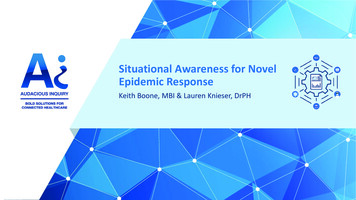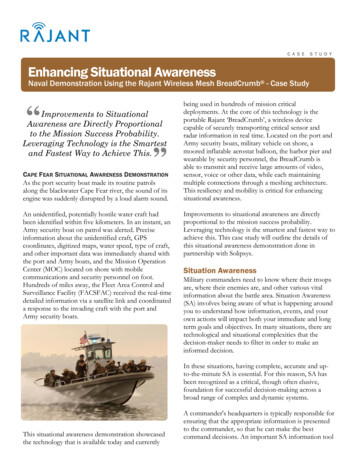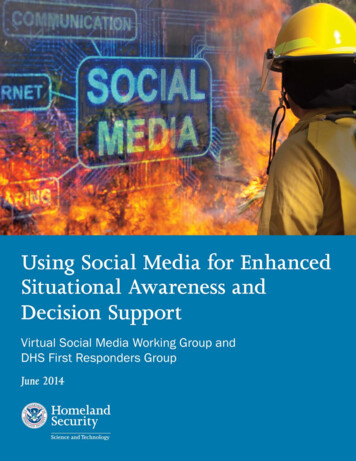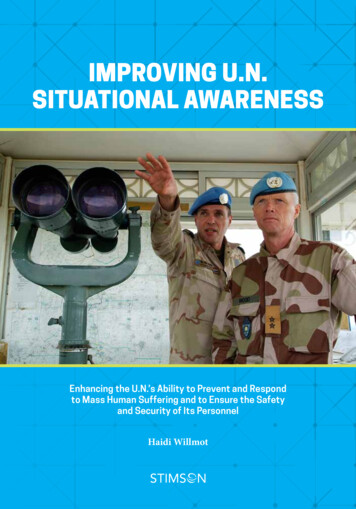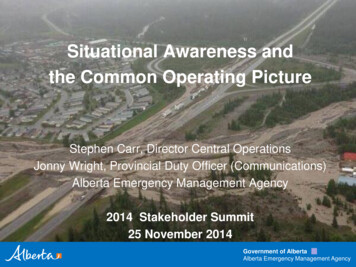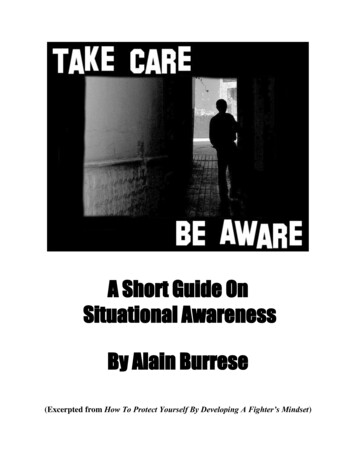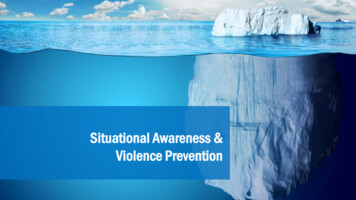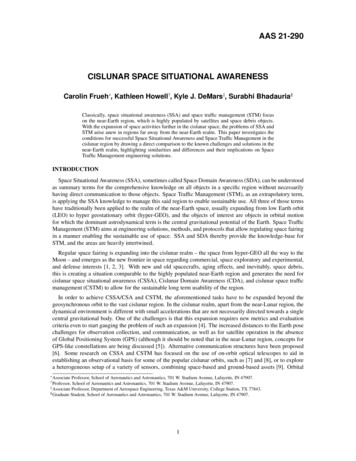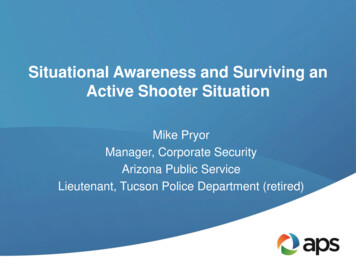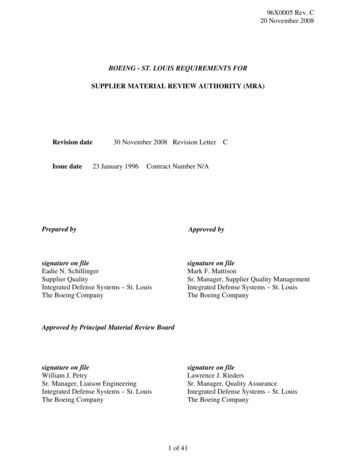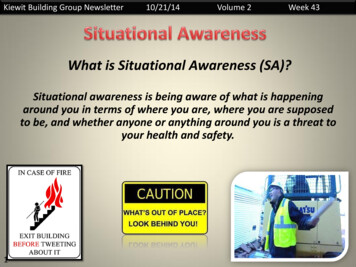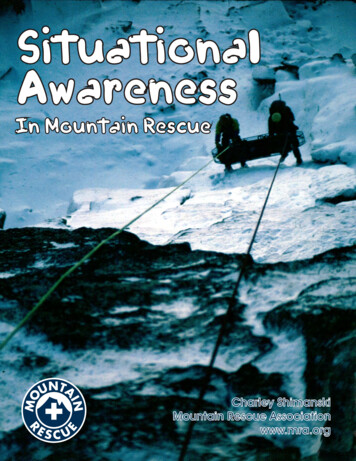
Transcription
SituationalAwarenessIn Mountain RescueCharley ShimanskiMountain Rescue Associationwww.mra.org
Charley ShimanskiMountain Rescue Associationwww.mra.org 2017, Charley Shimanski/Mountain Rescue Association – All rights reservedCOVER PHOTO: Rescuers on a litter lowering at 14,000 feet on Mount Evans, Colorado. Photoby Charley Shimanski.“OBJECTIVE” PAGE PHOTO: Courtesy Howard Paul
Table of ContentsObjective . 1Introduction . 1Situational Awareness. 1Data Collection and Interpretation. 1The Three Stages of Situational Awareness . 2Stage I - Perception of the Relevant Information . 2Stage II - Comprehension and Interpretation of the Relevant Information . 2Stage III - Projection into the Future . 4An Everyday Example of Situational Awareness . 4Seven Key Factors that Reduce Situational Awareness. 6Insufficient or poorly communicated information and communication . 6Fatigue and stress . 6Task underload .7Task overload .7Group mindset .7“Press on Regardless” Philosophy .7Degrading operating conditions . 8Additional Factors that Reduce Situational Awareness . 8Complacency at the Highest Level . 8Overconfidence Based on Experience. 8Common Errors in Situational Awareness . 10Stage I - Perception .10Stage II - Comprehension .10Stage III - Projection .10Ways to Avoid the Loss of Situational Awareness . 11Actively question and evaluate your mission progress . 11Analyze your situation . 11Update and revise your image of the mission. 12Use assertive behaviors when necessary . 12Make suggestions . 12Provide relevant information without being asked . 12Ask questions as necessary . 12Confront ambiguities . 12State opinion on decisions/procedures . 12Refuse unreasonable requests . 12Ways to Increase Situational Awareness . 13Break the chain . 13Useful Tips in Situational Awareness . 13Conclusion . 14Mountain Rescue Associationwww.mra.org
ObjectiveThe Mountain Rescue Association, a national non-profit membership association dedicated tosaving lives through rescue and mountain safety education, has developed this program to beused by any organization that may be required to respond to a backcountry rescue operation.At the conclusion of this course, students should be able to:1.2.3.4.Identify the three stages of Situational AwarenessUnderstand seven key factors that reduce Situational AwarenessRecognize common errors in Situational Awareness, andIdentify ways to avoid the loss of Situational AwarenessThis program would not have been possible without the kind assistance of many mountaineersand rescuers. Our thanks to all who offered assistance.About the AuthorCharley Shimanski is Past President and Education Director for the Mountain RescueAssociation, a national organization of rescue mountaineers. The US delegate to the Air RescueCommission of the International Commission for Alpine Rescue.(www.alpine-rescue.org) andMountain Rescue Program Coordinator for Flight For Life Colorado, Charley is also a 25-yearveteran of Colorado’s Alpine Rescue Team, He has participated as a field member and IncidentCommander for hundreds of rescues among Colorado’s highest peaks.The author of the Mountain Rescue Association’s Helicopters in Mountain Rescue Operationsmanuals and several others, Charley has consulted rescue mountaineers, mountain guides, andclimbers throughout the world, from Israel to China, from Kilimanjaro to Aconcogua. Charleyhas presented at meetings of International Commission for Alpine Rescue, InternationalTechnical Rescue Symposium, The National Association of Search and Rescue, the WildernessMedical Society, and the Mountain Rescue Association.
Situational Awareness inMountain RescueIntroductionIn the past number of years, search andrescue teams have turned their attention torisk management. This focus on risk, andthe subsequent increased efforts to mitigaterisk, means that search and rescueorganizations must constantly stay aware oftrends and advances in risk managementtechniques and philosophies. “SituationalAwareness” is a term that has found its wayinto the vocabulary of SAR teams and SARleaders over the past few years.SituationalAwareness“Situational Awareness” is “the degree ofaccuracy by which one’s perception ofhis/her current environment mirrorsreality.” The essence of SituationalAwareness is fairly simple perception vs.reality.For over 30 years, Situational Awarenesshas been studied and applied in military,civil, commercial and aerospaceapplications. More and more, emergencyservice organizations are focusing onsituational awareness as a key factor inreducing risk and increasing safety.Introduction1interpret data gathered from theenvironment. In the case of search andrescue operations, the “human detector” canbe anything from the Incident Commanderto a “field grunt.” That is the beauty (andchallenge) of situational awareness – itrequires and demands awareness by allusers.In a search and rescue response, the“information” that is collected can come inmany forms, including:1. Information provided by outsidesources (e.g. interviews withreporting parties, informationprovided by local law enforcement,etc.)2. Information from the environment(e.g. weather)3. Information from previousexperiences (e.g. other SAR missionsin the same location)Situational Awareness is also much like theIncident Command System (ICS), in that itis flexible and should grow or shrink as theSAR incident grows or shrinks.Situational Awareness can also be looked atas a constantly evolving picture of the stateof the environment. It is the perception andcomprehension of the relevant elements inan incident within a volume of time andspace. In this regard, Situational Awarenessis not an event, but rather a process thatonly ends when the SAR incident isconcluded.Data Collection andInterpretationSituational Awareness requires the humanoperator to quickly detect, integrate andMountain Rescue Associationwww.mra.org
Situational Awareness inMountain RescueThe Three Stages ofSituationalAwarenessTo fully understand Situational Awareness,we need to look closely at its threeimportant stages. They are:1. The perception of the relevantinformation;2. Thecomprehensionandinterpretation of that information;and3. The projection of their states into thefuture.Each of these stages is examined in detailbelow:Stage I - Perceptionof the RelevantInformationYogi Berra once said, “You can observe a lotby just watching.” Observation is the key toperception. In this first step of situationalawareness, we are looking for clues. Theseclues can come in many forms, including: Sensory clues - something you see,hear, smell, touch;Anticipated clues - something thatcomes from prior experience; andInnate clues – something you just“feel in your gut.”In conventional search missions, forexample, rescuers are looking for CLUESmore than they are looking for the missingsubject. Why? Simply because there are farmore clues than there are missing subjects,and by finding and following clues, one canfind the missing subject much more quickly.Mountain Rescue AssociationThree Stages of SituationalAwareness2The first stage of situational awareness –perception – is arguably the most importantstage. After all, without perception ofinformation, one cannot really comprehend,interpret and draw conclusions.Many accidents in search and rescueoperations result from a series of differentthings happening. There are often anumber of contributing factors that, ifoccurring individually, might not haveresulted in an accident. Break any rescueaccident down, and you will often find thatthere were a number of elements that cametogether to make that accident possible.In this important perception stage ofSituational Awareness, rescuers need to bevery attentive – not only to the occurrenceof situations that are beyond theirexpectations, but to the frequency andnumber of those situations.This perception stage requires that youOBSERVE! In order to be an effectiveobserver, one must remain attentive. Thiscan be one of the greatest challenges to asearch and rescue professional, as periods ofinactivity and boredom can hamper one’sability to be an effective observer.Similarly, searchers and/or rescuers whoare overworked might not be able to observethe environment around them. This too canbe a serious detriment to one’s ability to bean effective observer.Stage II Comprehension andInterpretation of theRelevant InformationThe second stage of Situational Awareness,“comprehension and interpretation,”requires you to have and utilize yourtraining and experience. Training is a keycomponent of teaching SAR workers, butwww.mra.org
Situational Awareness inMountain Rescueexperience is the key to understanding howto best utilize that training.The second stage of Situational Awarenessis the stage wherein one attempts tocomprehend and interpret the data collectedin the first stage. While the collection ofdata and the perception of the relevantinformation are important, thecomprehension and interpretation of thatdata can not be overlooked.The key to this stage of SituationalAwareness is that it requires one to haveand utilize key training and experience. Forexample, a rescuer in a high mountainrescue might have already perceived thatthe temperature is very hot. Still, withoutproper training in helicopter management,that rescuer he might not be able tointerpret that the high temperatures willhave an effect on the rescue team’s use ofhelicopter resources – since temperaturehas a significant effect on helicopterperformance at altitude. Without theproper training, a SAR worker might not beaware of the limitation that temperature hason the performance of helicopter assets.Experience is also a key factor in this stageof Situational Awareness. While training isessential for any SAR professional, there isno substitute for experience. It is throughexperience that we learn and master theimportant skills associated with interpretingdata that is presented in the first stage ofsituational awareness.Understanding the CluesIn order to interpret clues, you must firstunderstand them. But how do you interpretclues if those clues do not make sense? On asearch for a missing hiker one summernight, a rescue professional notified thesearch command post that he’d found “abunch of orange pails” in the middle of atrail while searching. The searcher went onto say that the pails were meticulously laidout in the shape of an arrow, pointing downMountain Rescue AssociationThree Stages of SituationalAwareness3the trail. The Incident Command teamstruggled to figure out why there would beorange pails many miles back on a remotebackcountry trail. Several minutes later, thecommand team asked for a clarificationfrom the rescuer, who coincidently was asoutherner with a deep southern drawl inhis voice. He was asked, “What kind oforange pails are these?” The man replied“You know, the kind of pails you pail off anorange before you eat it!” The man wastalking about orange PEELS, but that onlybecame evident after the command teamasked more questions. The data presenteddid not make sense at first, but madecomplete sense later, once the commandteam remembered that the field rescuer wasfrom Georgia, and had a distinct southerndrawl.Interpreting the CluesRequires TrainingDo you have sufficient experience tointerpret the information that you haveassembled? Traditional training might notteach you the skills necessary. For example,one search and rescue team trains itsmembers on helicopter skills in a uniqueand different way the rescuers are notschooled in how to help a helicopter pilot,rather they are schooled in how to BE ahelicopter pilot by learning how a pilotactually FLIES a helicopter. As such, theseSAR professionals are better able to thinklike a pilot.Recognizing the Frequency ofthose CluesAs mentioned earlier, one should not onlypay attention to the clues themselves, butalso to the frequency of clues. This can helpa rescuer ascertain whether numerousseemingly inconsequential anomalies arecoming together to draw one large problem.In a later section, "Break the Chain,” we willreview an example of a rescue accidentwww.mra.org
Situational Awareness inMountain RescueThree Stages of SituationalAwareness4where numerous elements compoundedupon themselves and the accident occurred.INTERPRETING, but not PROJECTINGinto the future.Stage III - Projectioninto the FutureIf, on the other hand, you instead look forclouds, then you have added PROJECTINGinto your situational awareness. In thatcase, you are more able to anticipate rainBEFORE it arrives.The third stage of situational awareness –projection into the future – is the stagewhere one puts it all together. Once theclues are interpreted, the next step is toproject how that information will affect thefuture of the operation.Let’s use an example of a traditionalbackcountry search. Rescuers are called to alocal trailhead to search for a subject who is6 hours overdue from a planned hike. Thesubject told the reporting party (his wife)that he was going fishing at a local lake onthe trail. While some rescuers are searchingthe trail to the lake, other rescuers alsosearch the subject’s car, and find that hisfishing equipment is still in the back seat,including his fishing license. Using this newinformation, the rescuers conclude that theyneed to expand their search area based onthe projection that the man changed hisplans, and did not go fishing at the lake asexpected.An EverydayExample ofSituationalAwarenessLet’s consider another example ofsituational awareness, one that takes placein an everyday setting.If you want to know if it is going to rain, youdon’t look for rain, you look for CLOUDS. Ifyou look for rain you’ll only know that rainis coming at the very moment that it arrives.Looking for rain alone would mean that youare only OBSERVING andMountain Rescue AssociationStill, even looking for clouds does notconstitute the only important element thatis missing if you only look for rain. Youneed some training to know WHAT TYPESof clouds cause rain. For example, a suddenbuild up of high cirrus clouds meanssomething completely different than asteady accumulation of cumulonimbusclouds. Only through training andexperience can you learn this importantdistinction.Visualize While En Route to aCallIn many emergency medical trainingprograms, students are taught the value ofvisualizing the scenario prior to arriving atthe rescue call. In search and rescueoperations, rescuers often have an extendedperiod of time traveling to the scene of theSAR call. During that transport time, it canbe valuable to take the clues given (e.g. thedescription of the rescue accident) andproject into the future what kind ofproblems will be encountered by the rescueteam. For example, a rescuer may knowthat a rescue of an injured climber on theeast side of Highway 9 means that therescue team will need to create a technicalsystem to cross above a large creek. Whileen route to the call, rescuers will already beplanning in their heads the tyrolean systemnecessary for the creek crossing.Similarly, SAR field teams can talk abouttheir pending rescue while heading into thefield. On a recent rescue of a survivor froman avalanche, rescuers were performing atechnical lowering of the patient to a rockband where the helicopter could “hover-www.mra.org
Situational Awareness inMountain RescueThree Stages of SituationalAwareness5load” the patient. During that technicallowering, the helicopter crew members weresitting in their helicopter at the trailheadparking lot. The rotors were turning, andthe crew was discussing in great detail howthey would do the “hot-load” of the subject.They could have been discussing the latestbasketball game, or the lovely weather, butinstead they used the opportunity to briefeach other on what their duties would be,and on what possible complications mightoccur.Experience teaches rescuers toANTICIPATE possible scenarios based oninformation provided. Still, that sameexperience teaches rescuers that theinformation provided may be wrong. Whileat work one day, an out-of-breath co-workerran into my office and said, “Charley do youknow CPR?” I followed the co-worker to thehallway, where another staff member waslying on the ground, seemingly lifeless.Prior to starting CPR, I checked mycolleague for a pulse, and asked bystanderswhat happened. They described the patientas having experienced what sounded to melike a Grand Mal seizure. Indeed the patientwas in a Post Ictal state, and was not in needof CPR.Mountain Rescue Associationwww.mra.org
Situational Awareness inMountain RescueSeven Key Factorsthat ReduceSituationalAwarenessThe United States Navy developed seven keyfactors that reduce situational awareness:Navy1. Insufficient or poorly communicatedinformation and communication;2. Fatigue and stress ;3. Task underload;4. Task overload;5. Group mindset;6. “Press on Regardless” philosophy;and,7. Degrading operating conditions.Each of these factors is detailed below.Insufficient or poorlycommunicatedinformation andcommunicationInsufficient or poorly communicatedinformation and communication can bedisastrous, particularly when the well-beingof a search or rescue subject is concerned.One particular example where informationcan be poorly communicated is when SARteams in remote areas use radio relays inplaces where radio communication is poorbetween field teams and the command post.Inexperienced relays can reinterpret themessage when transmitting it, rather thanrepeating EXACTLY what they heard.After the Space Shuttle Challenger wasdestroyed 73 seconds after liftoff, NASAMountain Rescue AssociationSeven Factors that ReduceSituational Awareness6determined that one of the contributorycauses was that “The Commission istroubled by what appears to be a propensityat Marshall (Space Flight Center) to containpotentially serious problems, and to attemptto resolve them internally rather thancommunicate them forward. This tendencyis altogether at odds with the need forMarshall to function as part of a systemworking toward successful flight mission,interfacing and communicating with theother parts of the system that work to thesame end. ”After the Space Shuttle Columbia wasdestroyed on re-entry, NASA convened apanel of experts to review the accident. TheColumbia Accident Investigation Board(CAIB) concluded that “poorlycommunicated information” was acontributing factor in the events that led upto the loss of the orbiter on re-entry. Theywent on to specify that the use of thecomputer presentation software,“PowerPoint,” played a role, as presentersoften had to find ways to distill pages andpages of information onto singlePowerPoint slides for their presentations.Fatigue and stressFatigue and stress reduce one’s ability tomake important observations andinterpretations. For this reason, it is veryimportant that rescuers monitor each other,and monitor shift durations during SARoperations. Any extended SAR operationshould include a place for rescuers to rest orsleep in between shifts.Realizing that fatigue and stress reduceone’s abilities, the airline industry hasimplemented strict regulations regardingthe number of hours that flight crewmembers can fly before they are required tohave a day off. For the same reason, mostEmergency Medical Services agencies haveinstituted similar regulations.www.mra.org
Situational Awareness inMountain RescueTask underloadTask underload can introduce an importantproblem the boredom factor. Taskunderload is one contributory factor inmany motor vehicle accidents. It has alsohas been cited as a frequent problem forpersons in certain occupations, such assecurity guards.Task underload was a factor in a fatal planecrash during a search operation in Coloradoin 1988. While flying at their assignedaltitude of 13,000 feet during a search, theplane’s pilot told the spotter that he wasbored, and that they were going to fly at11,000 feet. He descended to this loweraltitude. Shortly thereafter, the planecrashed in a downdraft. The pilot waskilled, although his spotter survived.One way to combat this problem is to closelymonitor the tasks that are assigned topeople. If some personnel are withouttasks, find tasks for them to do.On a recent search, a rescuer who wasawaiting a field assignment decided to setup his spotting scope at the command Post.Within several minutes, he spotted themissing party high on a ridge. Similarly, arescuer at an avalanche rescue decided tospot probe the avalanche debris while shewas awaiting her assignment. While doingso, she happened to find the buried victim.Task overloadTask overload is also an important factorthat reduces situational awareness. Theprobability of human error increases withlength and complexity of tasks.Task overload is one reason why manystates have made it illegal to operate amotor vehicle while using a cellulartelephone.Again, an effective method to combat thisproblem is to closely monitor the tasks thatMountain Rescue AssociationSeven Factors that ReduceSituational Awareness7are assigned to any individual. Taskoverload is often easy to recognize.Although not specifically stated in theNavy’s “Seven Factors that ReduceSituational Awareness,” some studies haveshown that one key time where seriousmistakes are made is during theTRANSITION from task overload to taskunderload – at time at which a rescuermight “let his guard down.” Similarly, thetransition from task underload to taskoverload may be a time when rescuers makemistakes – particularly because the braintakes some time to transition from a level ofboredom to a level of high activity.Group mindsetGroup mindset was also cited as a factorthat reduces situational awareness. Groupmindset refers to the fact that one’spropensity to agree with a group increasesas the size of the group increases.So, the group all agrees, right? Or does it?Could it be that some of the group membersagreed due to peer pressure?An accident investigation board wasassembled in 1967 after the Apollo I disasterin which Gus Grissom, Edward White, andRoger Chaffee were killed in a fire aboardthe spacecraft just days before their plannedlaunch. In assembling their list ofcontributing factors, the Board coined a newphrase: “Go Fever.”“Press onRegardless”PhilosophyOnce a plan has been developed, a “press onregardless” philosophy can take shape. Thiscan be detrimental to the ability toadequately reevaluate and alter or abandona plan.www.mra.org
Situational Awareness inMountain RescueThe first disaster involving a Space Shuttle– The Challenger on January 28, 1986 – is agood example of the “press on regardless”philosophy. Known defects in the O-rings ofthe solid rocket booster had been identifiedas early as 1979, but NASA officials pressedon with the Space Shuttle program anyways.Numerous shuttle engineers expressed theirconcerns, but those concerns were dispelledand the space shuttle program continued.“The decision to delay a shuttle launch haddeveloped into an ‘unwanted’ decision bythe members of the Shuttle team. In otherwords, suggestions made by any groupmember that would ultimately support ashuttle launch were met with positivesupport by the group. Any suggestion thatwould lead to a delay was rejected by thegroup ”Degrading operatingconditionsIn SAR operations, degrading operatingconditions can come in many forms. Often,this can be associated with bad weatherconditions. Whenever this occurs, rescuersshould consider slowing their pace toprovide time to recognize whether thechange in weather is affecting their efforts.Additional Factorsthat ReduceSituationalAwarenessIn addition to the seven key factorsidentified by the Navy above, we haveidentified two additional factors that canreduce situational awareness in rescueorganizationsSeven Factors that ReduceSituational Awareness8Complacency at theHighest LevelOne factor that seems to be prevalent inmany SAR organizations is complacencyamong those most experienced members ofthe team. It seems that as members of SARteams acquire ten or more years’ experience,they can tend to develop a perception thatthey are the teachers in the organization,and that there is little left for them to learn.Still, as the world of SAR evolves, there ismore for these experienced members tolearn.Young or newer members of SAR teamsseem less prone to this complacency duringthe period where they experience a steeplearning curve.OverconfidenceBased on ExperienceDr. Ken Kamler was an expedition physicianon a Mt. Everest expedition in 1996 – theyear that several climbers tragically losttheir lives in a storm. Dr. Kamlerhypothesized from that tragedy that some ofthe climbers were lulled into a false sense ofsecurity on the mountain, due in large partto the fact that they had successfullyclimbed Mt. Everest many times before.From this observation, Kamler suggestedthat, “Familiarization, and prolongedexposure without incident, leads to a loss ofappreciation of risk.”This can be especially true in SARorganizations, where leaders can tend tostay with the organization for a long time.The longer and more frequently that one issuccessful and error-free, the easier it is forthat person to lose sight of the risksassociated with the particular activity.Consider, as an example, that mostavalanche victims have had avalancheMountain Rescue Associationwww.mra.org
Situational Awareness inMountain RescueSeven Factors that ReduceSituational Awareness9training. It is not the novice who isnormally caught in an avalanche, but ratherthe experienced and educated winterbackcountry traveler. This is because theexperienced backcountry user can tend tolet his/her guard down.Mountain Rescue Associationwww.mra.org
Situational Awareness inMountain RescueCommon Errors inSituational Awareness10Common Errors inSituationalAwarenessperformed, and to mitigate that to thegreatest extent possible.Bill Wade is a recently retired National ParkService Superintendent for many years, andformer Education Director for the NationalAssociation for Search and Rescue(NASAR). Mr. Wade developed several“Common Errors in SituationalAwareness. ” These are presented in detailon the following pages.Too little experienceStage I - PerceptionToo much or too littleinformationIt is a challenge to interpret information ifthere is too little information to interpret inthe first place. Similarly, rescuers can beparticularly challenged if there is too muchinformation to interpret.Failure to adequately reviewthe informationAnother common error is for the rescuers tospend too little time adequately reviewingthe information that has become available.A prudent Incident Commander willdedica
situational awareness as a key factor in reducing risk and increasing safety. Situational Awareness can also be looked at as a constantly evolving picture of the state of the environment. It is the perception and comprehension of the relevant elements in an incident within a volume of time and spac
